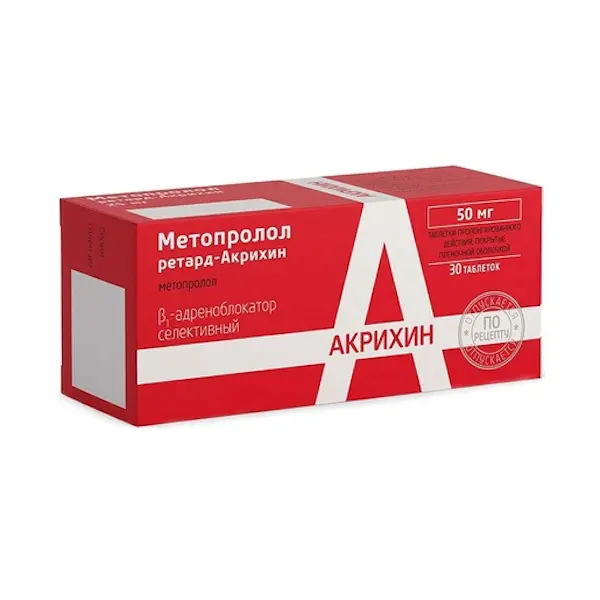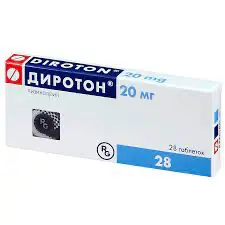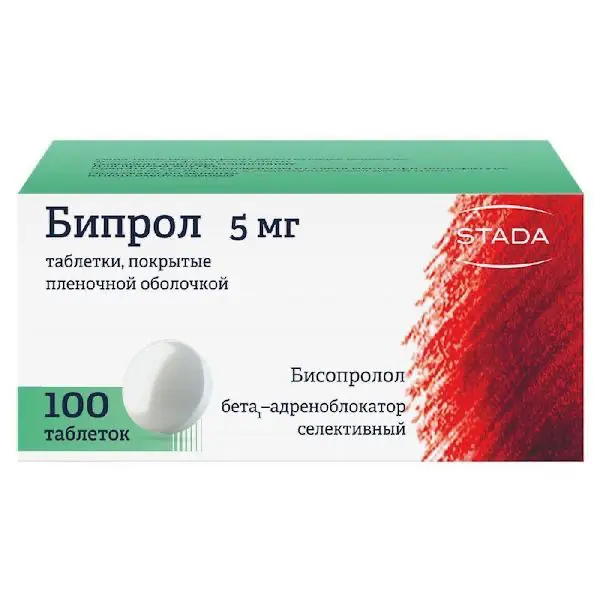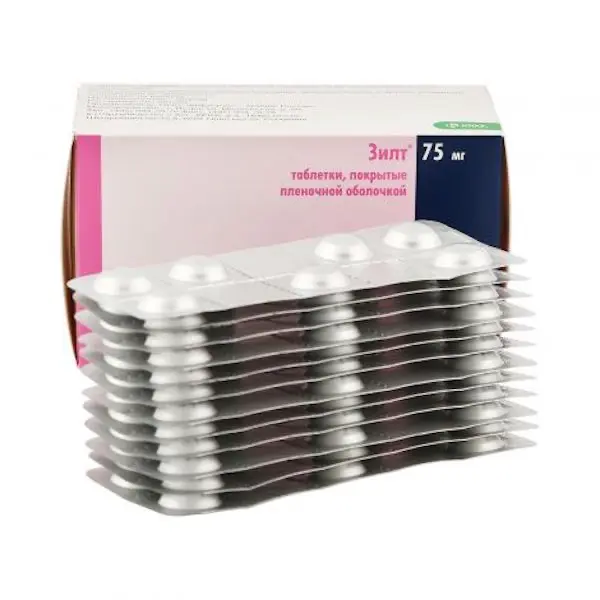Description
Metoprolol Retard-Acrihin Pharmacodynamics
Cardioselective beta1-adrenoblocker. It has no membrane stabilizing effect and no intrinsic sympathomimetic activity. It has antihypertensive, antianginal and antiarrhythmic effects. By blocking in low doses beta1-adrenoreceptors of the heart, it reduces catecholamine-stimulated formation of cyclic adenosine monophosphate (cAMP) from adenosine triphosphate (ATP), reduces intracellular calcium ion current, has negative chrono-, dromo-, batmo- and inotropic effects (decreases heart rate (HR), inhibits conduction and excitability, reduces myocardial contractility). Total peripheral vascular resistance (TPR) at the beginning of beta-adrenoblocker use (during first 24 hours after peroral administration) increases (as a result of reciprocal increase of alpha-adrenoreceptors activity and elimination of beta2-adrenoreceptors stimulation), which returns to baseline in 1-3 days, and decreases after prolonged use.
Antihypertensive effect is caused by decrease in minute blood flow volume and renin synthesis, inhibition of renin-angiotensin-aldosterone system activity (it is more important in patients with initial renin hypersecretion) and central nervous system, restoration of aortic arch baroreceptors sensitivity (their activity does not increase in response to arterial pressure (BP) decrease and finally reduction of peripheral sympathetic effects. Reduces elevated BP at rest, during physical stress and strain. The antihypertensive effect lasts more than 24 hours. The antianginal effect is determined by a decrease in myocardial oxygen demand due to a decrease in HR (prolongation of diastole and improvement of myocardial perfusion) and contractility, as well as a decrease in myocardial sensitivity to the effects of sympathetic innervation. It reduces the number and severity of angina attacks and increases exercise tolerance. By increasing left ventricular end-diastolic pressure and increasing ventricular muscle fiber stretch may increase oxygen demand, especially in patients with chronic heart failure (CHF).
Antiarrhythmic effect is caused by elimination of arrhythmogenic factors (tachycardia, increased activity of sympathetic nervous system, increased content of CAMF, arterial hypertension), reduction of spontaneous excitation rate of sinus and ectopic pacemakers and slowing of atrioventricular (AV) conduction (predominantly in antegrade and to a lesser extent in retrograde direction through AV node) and by additional pathways. In supraventricular tachycardia, atrial fibrillation, sinus tachycardia in functional heart disease and thyrotoxicosis, it reduces HR or may even lead to restoration of sinus rhythm.
Prevents the development of migraine. In contrast to non-selective beta-adrenoblockers, when administered in medium therapeutic doses, it has less pronounced effect on the organs containing beta2-adrenoreceptors (pancreas, skeletal muscles, smooth muscle of peripheral arteries, bronchi and uterus) and on carbohydrate metabolism; intensity of atherogenic action does not differ from that of propranolol.
When administered for many years, it reduces blood cholesterol concentration. When used in high doses (more than 100 mg/day), it has a blocking effect on both beta-adrenoreceptor subtypes.
Indications
-Arterial hypertension.
-Stenocardia.
Stable symptomatic chronic heart failure with impaired left ventricular systolic function (as adjunctive therapy to the main treatment of chronic heart failure).
-Lower mortality and recurrent myocardial infarction rate after the acute phase of myocardial infarction.
-Heart rhythm disorders, including supraventricular tachycardia, reduced rate of ventricular contractions in atrial fibrillation and ventricular extrasystoles.
-Functional disorders of cardiac activity accompanied by tachycardia.
-Prevention of migraine attacks.
Contraindications
Hypersensitivity to metoprolol and other beta-adrenoblockers, cardiogenic shock, II-III degree AV blockade, sinoatrial blockade, sinus node weakness syndrome, severe bradycardia (heart rate less than 50 bpm), acute heart failure or CHF in decompensation, hypotension (systolic BP less than 90 mm Hg). pulses), acute myocardial infarction (heart rate less than 45 beats/min, PQ interval greater than 0.24 s, systolic BP less than 100 mm Hg. systolic BP less than 100 mm Hg). ), breastfeeding period, concomitant use of monoamine oxidase inhibitors (MAOIs) or concomitant intravenous administration of verapamil, pheochromocytoma (without concomitant use of alpha-adrenoblockers), age under 18 years (effectiveness and safety not established), lactase deficiency, lactose intolerance, glucose-galactose malabsorption, severe bronchial asthma, severe peripheral circulatory disorders.
With caution:
Diabetes mellitus, grade I atrioventricular blockade, Prinzmetal angina, metabolic acidosis, bronchial asthma, chronic obstructive pulmonary disease, renal and/or severe hepatic insufficiency, myasthenia gravis, pheochromocytoma (when concomitant use of alpha-adrenoblockers), thyrotoxicosis, depression (incl. history), psoriasis, peripheral circulatory disorders (“intermittent” claudication, Raynaud’s syndrome), pregnancy, old age.
Pregnancy and lactation:
As with most beta-adrenoblockers, Metoprolol Retard-Acrihin should not be used during pregnancy and during breastfeeding unless the expected benefit to the mother exceeds the potential risk to the fetus and/or child. As with other hypotensive agents, beta-adrenoblockers may cause side effects such as bradycardia in the fetus, newborns, or breastfed infants.
The amount of metoprolol that passes into breast milk and the beta-adrenal blocking effects of metoprolol in a breastfed infant (when the mother takes metoprolol at therapeutic doses) are insignificant. It is recommended to monitor for signs of beta-adrenergic receptor blockade in breastfed infants (in case the nursing mother receives therapy with the drug).
Dosage and administration
- Metoprololol retard-Acrichine is intended for oral administration once a day, it is recommended to take in the morning, without chewing, with water. Metoprolol retarde-Acrichine can be taken regardless of meals. In order to prevent bradycardia, the dose is adjusted individually and increased gradually.
- In case of arterial hypertension, the recommended dose of Metoprolol retarde-Acrichine is 50-100 mg once a day. If necessary, the dose can be increased to 100 mg per day or another antihypertensive agent can be added, preferably a diuretic and a calcium antagonist of dihydropyridine series
- For angina pectoris, the recommended dose of Metoprolol retard-Acrichine is 100-200 mg per day. If necessary, another antianginal drug may be added to therapy.
- In stable symptomatic chronic heart failure with impaired left ventricular systolic function.
- Patients must be in stable chronic heart failure without an episode of exacerbation within the past 6 weeks and without changes in underlying therapy within the past 2 weeks.
- Therapy of heart failure with beta-adrenoblockers may sometimes lead to a temporary worsening of the symptomatic picture. In some cases, it is possible to continue therapy or reduce the dose, in some cases it may be necessary to withdraw the drug.
- In chronic heart failure II functional class according to NYHA classification (without exacerbations during last 6 weeks and without changes in complex therapy during last 2 weeks) the recommended initial dose is 25 mg once a day. Two weeks later, the daily dose may be increased to 50 mg, then after two weeks to 100 mg, and after another two weeks to 200 mg.
- The maintenance dose for long-term treatment is 200 mg Metoprolol retard-Acrihin once a day.
- In chronic heart failure III-IV functional class according to NYHA classification, the recommended initial dose for the first 2 weeks is 12.5 mg of the drug once daily. For 12.5 mg metoprolol dosing regimen, it is recommended to prescribe the drug in the form of 12.5 mg tablets or in the form of 25 mg tablets with a rib. The dose is adjusted individually. During the period of increasing the dose, the patient should be monitored, because in some patients the symptoms of heart failure may worsen.
- After 1 to 2 weeks, the dose may be increased to 25 mg once daily. Then after 2 weeks, the dose may be increased to 50 mg once daily. In patients who tolerate the drug well, the dose may be doubled every 2 weeks until a maximum dose of 200 mg of the drug once daily is reached.
- In case of arterial hypotension and/or bradycardia, it may be necessary to reduce the concomitant therapy or reduce the dose of Metoprolol retard-Acrichine. Arterial hypotension at the beginning of therapy does not necessarily indicate that this dose of Metoprolol retard-Acrichine will not be tolerated during further long-term treatment.
- However, the dose should not be increased until the condition has stabilized. Renal function may need to be monitored.
- Maintenance treatment after myocardial infarction is 200 mg Metoprolol retard-Acrichine once daily.
- In cardiac rhythm disorders – 100-200 mg Metoprolol retard-Acrichine once daily.
- In functional disorders of cardiac activity accompanied by tachycardia – 100 mg per day, if necessary, the dose may be increased to 200 mg per day.
- Prevention of migraine attacks: 100-200 mg once daily.
- Renal dysfunction
There is no need to adjust the dose in patients with impaired renal function. - Impaired liver function
Due to the low degree of binding to plasma proteins, no dose adjustment is usually required for metoprolol. However, in severe hepatic impairment (in patients with severe cirrhosis or portocaval anastomosis) a dose reduction may be required.





